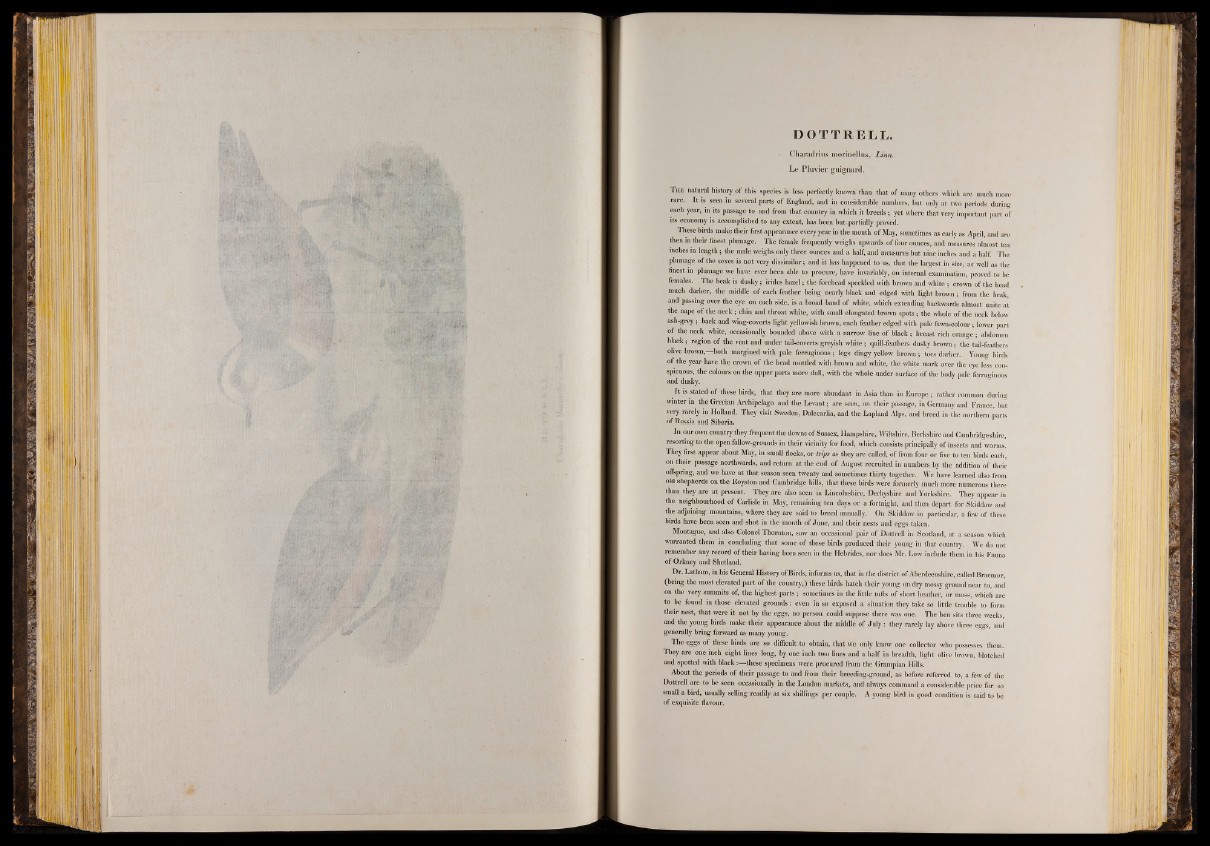
DOT TREL L .
Cha rad rius morinellus, Lin n .
L e P lu v ie r guignard .
The natural history o f this species is less perfectly known than that of many others which are much more
rare. It is seen in several parts o f England, and in considerable numbers, but only at two periods during
each year, in its passage to and from that country in which it breeds; yet where that very important part of
its economy is accomplished to any extent, has been but partially proved.
These birds make their first appearance every year in the month o f May, sometimes as early as April, and are
then in their finest plumage. The female frequently weighs upwards o f four ounces, and measures almost ten
inches in length; the male weighs only three ounces and a half, and measures but nine inches and a half. The
plumage o f the sexes is not very dissimilar; and it has happened to us, that the largest in size,'as well as the
finest in plumage we have ever been able to procure, have invariably, on internal examination, proved to be
females. The beak is dusky; irides hazel; the forehead speckled with brown and white ; crown o f the head
much darker, the middle o f each feather being nearly black and edged with light brown ; from the beak,
and jpassing over the eye on each side, is a broad band o f white, which extending backwards almost unite at
the nape o f the neck ; chin and throat white, with small elongated brown spots; the whole o f the neck below
ash-grey; back and wing-coverts light yellowish brown, each feather edged with pale fawn-colour; lower part
o f the neck white, occasionally bounded above with a narrow line o f black ; breast rich orange; abdomen
black; region o f the vent and under tail-coverts greyish white ; quill-feathers dusky brown; the tail-feathers
olive brown,— both margined with pale ferruginous ; legs dingy yellow brown ; toes darker. Young birds
o f the year have the crown o f the head mottled with brown and white, the white mark over the eye less conspicuous,
the colours on the upper parts more dull, with the whole under surface o f the body pale ferruginous
and dusky.
It is stated o f these birds, that they are more abundant in Asia than in Europe ; rather common during
winter in the Grecian Archipelago and the Levant; are seen, on their passage, in Germany and France, but
very rarely in Holland. They visit Sweden, Dalecarlia, and the Lapland Alps, and breed in the northern parts
o f Russia and Siberia.
In our own country they frequent the downs o f Sussex, Hampshire, Wiltshire, Berkshire and Cambridgeshire,
resorting to the open fallow-grounds in their vicinity for food, which consists principally o f insects and worms.
They first appear about May, in small flocks, or trips as they are called, of from four or five to ten birds each,
on their passage northwards, and return at the end o f August recruited in numbers by the addition o f their
offspring, and we have at that season seen twenty and sometimes thirty together. We have learned also from
old shepherds on the Royston and Cambridge hills, that these birds were formerly much more numerous there
than they are at present. They are also seen in Lincolnshire, Derbyshire and Yorkshire. They appear in
the neighbourhood o f Carlisle in May, remaining ten days or a fortnight, and then depart for Skiddaw and
the adjoining mountains, where they are said to breed annually. On Skiddaw in particular, a few o f these
birds have been seen and shot in the month o f June, and their nests and eggs taken.
Montague, and also Colonel Thornton, saw an occasional pair o f Dottrell in Scotland, at a season which
warranted them in concluding that some o f these birds produced their young in that country. We do not
remember any record o f their having been seen in the Hebrides, nor does Mr. Low include them in his Fauna
o f Orkney and Shetland.
Dr. Latham, in his General History o f Birds, informs us, that in the district o f Aberdeenshire, called Braemor,
(being the most elevated part o f the country,) these birds hatch their young on dry mossy ground near to, and
on the very summits of, the highest parts ; sometimes in the little tufts o f short heather, or moss, which are
to be found in those elevated grounds: even in so exposed a situation they take so little trouble to form
their nest, that were it not by the eggs, no person could suppose there was one. The hen sits three weeks,
and the young birds make their appearance about the middle o f J u ly : they rarely lay above three eggs, and
generally bring forward as many young.
The eggs o f these birds are so difficult to obtain, that we only know one collector who possesses them.
They are one inch eight lines long, by one inch two lines and a half in breadth, light olive brown, blotched
and spotted with black:— these specimens were procured from the Grampian Hills.
About the periods o f their passage to and from their breeding-ground, as before referred to, a few o f the
Dottrell are to be seen occasionally in the London markets, and always command a considerable price for so
small a bird, usually selling readily at six shillings per couple. A young bird in good condition is said to be
o f exquisite flavour.